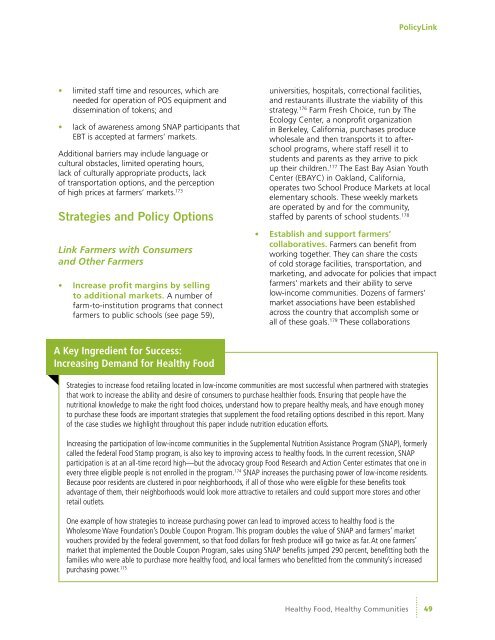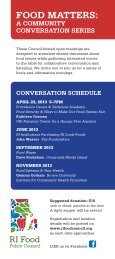Promising Strategies to Improve Access to Fresh, Healthy Food and ...
Promising Strategies to Improve Access to Fresh, Healthy Food and ...
Promising Strategies to Improve Access to Fresh, Healthy Food and ...
You also want an ePaper? Increase the reach of your titles
YUMPU automatically turns print PDFs into web optimized ePapers that Google loves.
PolicyLink• limited staff time <strong>and</strong> resources, which areneeded for operation of POS equipment <strong>and</strong>dissemination of <strong>to</strong>kens; <strong>and</strong>• lack of awareness among SNAP participants thatEBT is accepted at farmers’ markets.Additional barriers may include language orcultural obstacles, limited operating hours,lack of culturally appropriate products, lackof transportation options, <strong>and</strong> the perceptionof high prices at farmers’ markets. 173<strong>Strategies</strong> <strong>and</strong> Policy OptionsLink Farmers with Consumers<strong>and</strong> Other Farmers• Increase profit margins by selling<strong>to</strong> additional markets. A number offarm-<strong>to</strong>-institution programs that connectfarmers <strong>to</strong> public schools (see page 59),universities, hospitals, correctional facilities,<strong>and</strong> restaurants illustrate the viability of thisstrategy. 176 Farm <strong>Fresh</strong> Choice, run by TheEcology Center, a nonprofit organizationin Berkeley, California, purchases producewholesale <strong>and</strong> then transports it <strong>to</strong> afterschoolprograms, where staff resell it <strong>to</strong>students <strong>and</strong> parents as they arrive <strong>to</strong> pickup their children. 177 The East Bay Asian YouthCenter (EBAYC) in Oakl<strong>and</strong>, California,operates two School Produce Markets at localelementary schools. These weekly marketsare operated by <strong>and</strong> for the community,staffed by parents of school students. 178• Establish <strong>and</strong> support farmers’collaboratives. Farmers can benefit fromworking <strong>to</strong>gether. They can share the costsof cold s<strong>to</strong>rage facilities, transportation, <strong>and</strong>marketing, <strong>and</strong> advocate for policies that impactfarmers’ markets <strong>and</strong> their ability <strong>to</strong> servelow-income communities. Dozens of farmers’market associations have been establishedacross the country that accomplish some orall of these goals. 179 These collaborationsA Key Ingredient for Success:Increasing Dem<strong>and</strong> for <strong>Healthy</strong> <strong>Food</strong><strong>Strategies</strong> <strong>to</strong> increase food retailing located in low-income communities are most successful when partnered with strategiesthat work <strong>to</strong> increase the ability <strong>and</strong> desire of consumers <strong>to</strong> purchase healthier foods. Ensuring that people have thenutritional knowledge <strong>to</strong> make the right food choices, underst<strong>and</strong> how <strong>to</strong> prepare healthy meals, <strong>and</strong> have enough money<strong>to</strong> purchase these foods are important strategies that supplement the food retailing options described in this report. Manyof the case studies we highlight throughout this paper include nutrition education efforts.Increasing the participation of low-income communities in the Supplemental Nutrition Assistance Program (SNAP), formerlycalled the federal <strong>Food</strong> Stamp program, is also key <strong>to</strong> improving access <strong>to</strong> healthy foods. In the current recession, SNAPparticipation is at an all-time record high—but the advocacy group <strong>Food</strong> Research <strong>and</strong> Action Center estimates that one inevery three eligible people is not enrolled in the program. 174 SNAP increases the purchasing power of low-income residents.Because poor residents are clustered in poor neighborhoods, if all of those who were eligible for these benefits <strong>to</strong>okadvantage of them, their neighborhoods would look more attractive <strong>to</strong> retailers <strong>and</strong> could support more s<strong>to</strong>res <strong>and</strong> otherretail outlets.One example of how strategies <strong>to</strong> increase purchasing power can lead <strong>to</strong> improved access <strong>to</strong> healthy food is theWholesome Wave Foundation’s Double Coupon Program. This program doubles the value of SNAP <strong>and</strong> farmers’ marketvouchers provided by the federal government, so that food dollars for fresh produce will go twice as far. At one farmers’market that implemented the Double Coupon Program, sales using SNAP benefits jumped 290 percent, benefitting both thefamilies who were able <strong>to</strong> purchase more healthy food, <strong>and</strong> local farmers who benefitted from the community’s increasedpurchasing power. 175<strong>Healthy</strong> <strong>Food</strong>, <strong>Healthy</strong> Communities49



